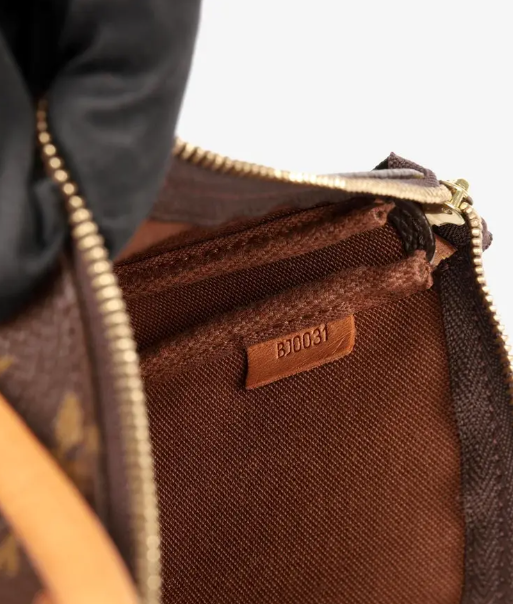
The Comprehensive Guide to Louis Vuitton Date Stamps: A History, Format, and Authentication Overview
Louis Vuitton date stamps, found on their leather goods, bags, accessories, and small leather items, play a significant role in identifying the authenticity and production details of their products. These embossed stamps include a combination of letters and numbers, which help collectors, buyers, and sellers verify whether an item is genuine, as counterfeiting can be a concern in the luxury market. Understanding these codes is essential, especially for those navigating the resale sector, where authenticating items is key.
The History of Louis Vuitton Date Stamps
Early 1980s: The Birth of Date Codes
Louis Vuitton introduced date codes in the early 1980s to combat the growing counterfeiting of its items. The initial design was simple, with a set of numbers that indicated the year and month of manufacture.
Late 1980s: The Addition of Factory Codes
By the late 1980s, the format evolved, adding letters to the date code to denote the specific factory where the item was made. This update included numbers for the date and two letters for the factory location.
1990-2006: The Standardisation of the Format
From 1990 to 2006, the date code system was standardised with two letters, followed by four numbers. The letters represented the manufacturing site, and the numbers indicated the month and year of production.
2007-2021: The Shift to Weekly Date Codes
Between 2007 and 2021, the format evolved further to include weekly data, where the numbers represented the week and the year the product was made.
2021: Transition to Microchips
In March 2021, Louis Vuitton replaced date codes with embedded microchips. These chips, placed discreetly within the products, store detailed information about the item, which enhances the security and authenticity checks.
Where to Find Louis Vuitton Date Stamps
The location of these stamps depends on the model and production year of the item. Here are the most common places where you can find Louis Vuitton date stamps:
- Interior Tags: Frequently found on a rectangular leather tag sewn into the interior seam, this is the most common spot for date codes.
- Direct Embossing: Some bags feature the date code embossed directly onto the lining or in less visible areas like near the top edge of an interior pocket.
- Interior Pockets: On certain models, such as the Speedy, the date code is often found on a leather tab sewn into the seam of the interior pocket.
Key Locations for Popular Louis Vuitton Bags:
- Speedy Bags: Date codes are typically on a leather tab inside the pocket seam.
- Neverfull Bags: These often feature a date code inside the interior zip pocket.
- Alma Bags: The date stamp can usually be found on a leather tab inside the pocket or seam.
- Keepall Bags: Commonly stamped on a leather tab attached to the handle or inside near the top edge.
How to Interpret Louis Vuitton Date Stamps
The format for Louis Vuitton date codes has changed over time. Here’s how to read them across different periods:
- Early 1980s: A series of three or four numbers, e.g., “836” for June 1983.
- Late 1980s: Three or four numbers followed by two letters, e.g., “874VX” for April 1987, made in France.
- 1990-2006: Two letters followed by four digits, e.g., “VI1025” for December 2005, made in France.
- 2007-2021: Two letters followed by four numbers for week/year codes, e.g., “SD2057” for the 25th week of 2007, made in the USA.
Country Codes in Louis Vuitton Date Stamps
Louis Vuitton’s date codes feature letters representing the country of origin. Below are examples of some codes:
- France: A0, A1, A2, VI, VX, and more.
- Italy: BC, BO, CE, MA, and others.
- Spain: BC, LO, LB, GI, and more.
- USA: FC, FH, LA, SD, and others.
- Germany: LP, OL.
- Switzerland: DI, FA.
Irregularities in Louis Vuitton Date Stamps
Some Louis Vuitton products manufactured in the 1970s and early 1980s, such as those produced under a license in the U.S. by The French Luggage Company, do not include date codes. Similarly, items produced for Saks Fifth Avenue under a special agreement with Louis Vuitton may have slight variations, making them rare and collectible.
How to Authenticate Louis Vuitton Items with Date Stamps
While date stamps are useful for verifying Louis Vuitton products, they are not foolproof. Counterfeit items can replicate these codes, so it’s important to assess other factors in authentication. At Xupes, experts examine various aspects of a Louis Vuitton item, including the craftsmanship, materials, and the accuracy of the date code, to ensure authenticity.
The Importance of Louis Vuitton Date Stamps in Valuation
Familiarity with Louis Vuitton date stamps can significantly enhance your ability to authenticate and assess the value of these luxury items. This knowledge is especially useful in the vintage and pre-loved market, where authenticity and condition directly affect an item’s resale value.
Factors That Influence Louis Vuitton Item Value:
- Rarity: Limited edition or customized pieces are more sought after.
- Condition: Items that show minimal wear are more valuable.
- Historical Significance: Items from significant collections or with a unique production history can fetch higher prices.
Conclusion
Being knowledgeable about Louis Vuitton date stamps helps you navigate the world of luxury items with confidence, whether you’re buying, selling, or simply collecting. These codes provide valuable insight into a product’s history, authenticity, and manufacturing details, especially in the pre-loved market. By understanding how to read and interpret these stamps, you can ensure that you’re getting the genuine article.
